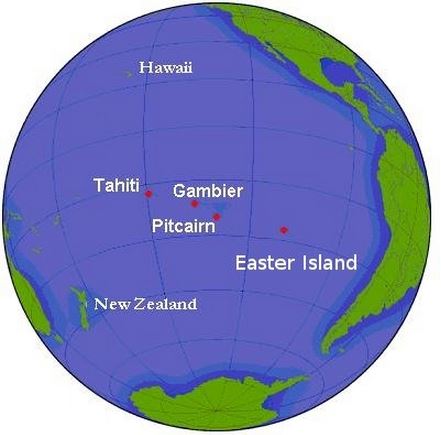The UK Government has announced it is setting up the world’s largest single marine reserve around the seas of Pitcairn Islands in the South Pacific, covering an area of 834,334 square kilometres (322,138 square miles), which is about 3.5 times the size of the UK and larger than Texas or California.
The announcement was included in Chancellor George Osborne’s March Budget published on Tuesday. For many, this wonderful bit of news mattered more than all the tax, spend and savings pledges made in the rest of the document.
The Pitcairn Group of Islands, midway between New Zealand and Chile, comprises four volcanic islands – Pitcairn (the only populated one), Oeno, Ducie and Henderson. Its population totals just 56 inhabitants.

The world’s largest single marine reserve. (Image: Pew Charitable Trusts)
Pitcairn’s population descends from British sailors who mutinied on the Royal Navy ship HMS Bounty (1798), and the Tahitian (or Polynesian) partners who settled with them.
In its document Budget 2015, HM Treasury wrote:
“The government intends to proceed with designation of a MPA (Marine Protected Area) around Pitcairn.”
“This will be dependent upon reaching agreement with NGOs on satellite monitoring and with authorities in relevant ports to prevent landing of illegal catch, as well as on identifying a practical naval method of enforcing the MPA at a cost that can be accommodated within existing departmental expenditure limits.”
Two organizations – the Pew Charitable Trusts (Pew) and the National Geographic Society – as well as the islanders welcomed the news.
Pew says the area, which is said to have the cleanest waters in the world, is home to over 1,249 species of seabirds, fish and marine animals and protects “some of the most near-pristine ocean habitat on Earth.”
In waters close to Henderson and Ducie, scientists found some of the healthiest populations of top predators, including sharks, of any underwater environment on Earth.
Several marine species are found only around the islands, such as the elusive Pitcairn angelfish, which was photographed for the first time in 2012, and the iconic Henderson petrel.

Pitcairn Islands waters are probably the cleanest in the world. (Image: Wikimedia)
Conservation proposal submitted in 2013
The Pitcairn Island Council, Pew and National Geographic submitted a proposal in 2013, calling for the creation of a marine reserve to protect the wildlife around the islands.
Director of Global Ocean Legacy, Matt Rand, said:
“With this designation, the United Kingdom raises the bar for protection of our ocean and sets a new standard for others to follow. The United Kingdom is the caretaker of more than 6 million square kilometres of ocean – the fifth-largest marine area of any country.”
“Through this designation, British citizens are playing a vital role in ensuring the health of our seas. The Pitcairn Islands Marine Reserve will build a refuge of untouched ocean to protect and conserve a wealth of marine life.”

The Titan Triggerfish, a voracious predator, being cleaned by a Cleaner Wrasse (a small fish between its eyes and mouth). (Image: National Geographic)
National Geographic congratulated the British Government on its move to stop the illegal fishing that threatens the survival of wildlife that lives in its territorial waters.
The new measure means that all seafloor mining and fishing will be banned in the marine reserve, with the exception of traditional fishing close to Pitcairn by the local population.
Today, thirty percent of all British waters around the globe are protected, the highest percentage of any country in the world.
National Geographic Explorer-in-Residence, Enric Sala, said:
“People know Pitcairn because of the Mutiny on the Bounty, but their real bounty is the rich marine life underwater. The Pitcairn Islands have some of the cleanest waters in the world.”
According to Reuters, about one fifth of all fish caught in our oceans are landed illegally. A 2009 study reported that illegal fishing was worth from $10 billion to $23.5 billion each year.
Pew Video – The Pitcairn marine reserve
